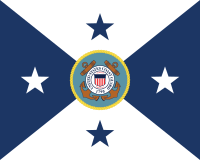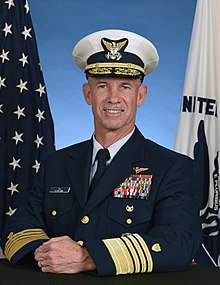
The Joint Chiefs of Staff (JCS) is the body of the most senior uniformed leaders within the United States Department of Defense, that advises the president of the United States, the secretary of defense, the Homeland Security Council and the National Security Council on military matters. The composition of the Joint Chiefs of Staff is defined by statute and consists of a chairman (CJCS), a vice chairman (VJCS), the service chiefs of the Army, Marine Corps, Navy, Air Force, Space Force, and the chief of the National Guard Bureau. Each of the individual service chiefs, outside their JCS obligations, work directly under the secretaries of their respective military departments, e.g. the secretary of the Army, the secretary of the Navy, and the secretary of the Air Force.

The chairman of the Joint Chiefs of Staff (CJCS) is the chief executive of the Joint Chiefs of Staff, who is the highest-ranking and most senior military officer in the United States Armed Forces and is the principal military advisor to the president, the National Security Council, the Homeland Security Council, and the secretary of defense. While the chairman of the Joint Chiefs of Staff outranks all other commissioned officers, the chairman is prohibited by law from having operational command authority over the armed forces; however, the chairman does assist the president and the secretary of defense in exercising their command functions.
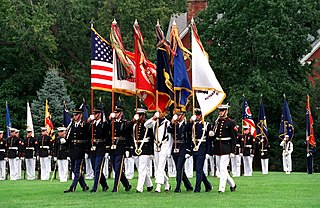
The several branches of the United States Armed Forces are represented by flags. Within the U.S. military, various flags fly on various occasions, and on various ships, bases, camps, and military academies.

The vice chief of naval operations (VCNO) is the second highest-ranking commissioned United States Navy officer in the Department of the Navy and functions as the principal deputy of the chief of naval operations and by statute, the vice chief is appointed as a four-star admiral.

The commandant of the United States Coast Guard is the service chief and highest-ranking member of the United States Coast Guard. The commandant is an admiral, appointed for a four-year term by the president of the United States upon confirmation by the United States Senate. The commandant is assisted by a vice commandant, who is also an admiral, and two area commanders and two deputy commandants, all of whom are vice admirals.
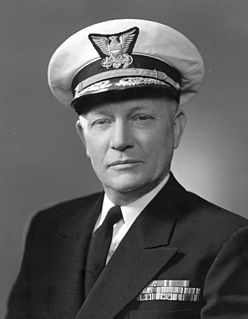
Merlin O'Neill served as the tenth Commandant of the United States Coast Guard from 1 January 1950 to 1 June 1954.
Admiral is a four-star commissioned naval flag officer rank in the United States Navy, the United States Coast Guard, and the United States Public Health Service Commissioned Corps, with the pay grade of O-10. Admiral ranks above vice admiral and below fleet admiral in the Navy; the Coast Guard and the Public Health Service do not have an established grade above admiral. Admiral is equivalent to the rank of general in the other uniformed services. The National Oceanic and Atmospheric Administration Commissioned Officer Corps has never had an officer hold the grade of admiral. However, 37 U.S.C. § 201 of the U.S. Code established the grade for the NOAA Corps, in case a position is created that merits the four-star grade.
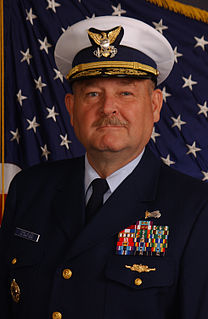
Thad William Allen is a former United States Coast Guard admiral who served as the 23rd Commandant of the Coast Guard. Allen is best known for his widely praised performance directing the federal response to hurricanes Katrina and Rita in the Gulf Coast region from September 2005 to January 2006, and for his role as National Incident Commander of the Unified Command for the Deepwater Horizon oil spill in the Gulf of Mexico in 2010. Robert J. Papp, Jr. succeeded him as Commandant on 25 May 2010, in a change of command ceremony.

Vice Admiral John P. Currier was the 28th Vice Commandant of the United States Coast Guard. He assumed the position from Vice Admiral Sally Brice-O'Hara on May 18, 2012 and was relieved on May 20, 2014 by Vice Admiral Peter Neffenger.
Previously, VADM Currier commanded Coast Guard District 13. He was relieved as district commander by Rear Admiral Gary Blore on July 14, 2009. Admiral Currier was selected for promotion to vice admiral and subsequently served as Chief of Staff of the Coast Guard.
A general denotes the most senior general-grade officer; it is the highest achievable commissioned officer rank that may be attained in the United States Armed Forces, with exception of the Navy. The official and formal insignia of General is defined by its four-stars.
This article covers the organization of the United States Coast Guard.
In the United States Armed Forces, a major general is a two-star general officer in the United States Army, Marine Corps, Air Force, and Space Force.

The Judge Advocate General of the Navy (JAG) is the highest-ranking uniformed lawyer in the United States Department of the Navy. The Judge Advocate General is the principal advisor to the Secretary of the Navy and the Chief of Naval Operations on legal matters pertaining to the Navy. The Judge Advocate General also performs other duties prescribed to them under 10 U.S.C. § 5148 and those prescribed under the Uniform Code of Military Justice.

A rear admiral in the U.S. uniformed services is either of two different ranks of commissioned officers: one-star flag officers and two-star flag officers. By contrast, in most nations, the term "rear admiral" refers to an officer of two-star rank.
Vice admiral is a three-star commissioned naval officer rank in the United States Navy, the United States Coast Guard, the United States Public Health Service Commissioned Corps, and the National Oceanic and Atmospheric Administration Commissioned Officer Corps, with the pay grade of O-9. Vice admiral ranks above rear admiral and below admiral. Vice admiral is equivalent to the rank of lieutenant general in the other uniformed services.
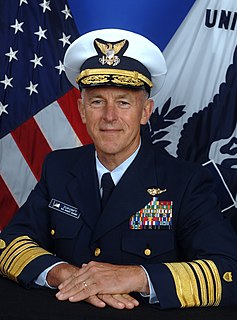
Paul Frederick Zukunft is a retired United States Coast Guard admiral who served as the 25th Commandant of the Coast Guard. He was confirmed by the U.S. Senate as the Commandant, with the rank of Admiral, in May 2014 and relieved Admiral Robert J. Papp Jr. as Commandant on 30 May 2014. Prior to his selection as Commandant, he served as Commander, Coast Guard Pacific Area. In this position, Zukunft was the operational commander for all U.S. Coast Guard missions within the half of the world that ranges from the Rocky Mountains to the waters off the East Coast of Africa. He concurrently served as Commander, Defense Force West and provided U.S. Coast Guard mission support to the U.S. Department of Defense and Combatant Commanders.

Charles David Michel is a former United States Coast Guard Admiral who last served as the 30th Vice Commandant of the U.S. Coast Guard. He is the first Vice Commandant to hold the rank of Admiral while in office. Originally a Vice Admiral when he assumed office on August 6, 2015, Michel was promoted to Admiral on May 24, 2016 when the Coast Guard Authorization Act of 2015 elevated the statutory rank for the position to admiral. Michel is also the first career judge advocate in any of the Armed Forces to achieve four-star rank. Michel retired from the Coast Guard on May 24, 2018 after over 33 years of service.
